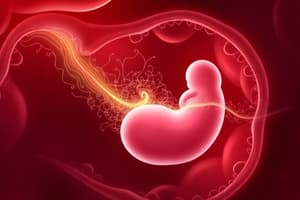Podcast
Questions and Answers
What is the primary function of chorionic villi during the embryonic stage?
What is the primary function of chorionic villi during the embryonic stage?
- They facilitate the attachment and implantation of the embryo into the uterus. (correct)
- They produce hormones that maintain the pregnancy.
- They provide nutrients and oxygen to the developing fetus.
- They help regulate the temperature within the amniotic sac.
Which of the following teratogens can potentially lead to microcephaly and cognitive impairment in the developing fetus?
Which of the following teratogens can potentially lead to microcephaly and cognitive impairment in the developing fetus?
- Zika (correct)
- Coumadin
- Rubella
- Lithium
What is the typical volume of amniotic fluid at term?
What is the typical volume of amniotic fluid at term?
- 1,500-2,000 mL
- 700-1,000 mL (correct)
- 100-200 mL
- 500-700 mL
What is the primary consequence of a missing chromosome on the X chromosome?
What is the primary consequence of a missing chromosome on the X chromosome?
Which of the following teratogens can cause deafness, cardiac anomalies, and miscarriage?
Which of the following teratogens can cause deafness, cardiac anomalies, and miscarriage?
What does the term 'nullipara' refer to?
What does the term 'nullipara' refer to?
A pregnant woman is in the 36th week of her pregnancy. What term best describes this stage?
A pregnant woman is in the 36th week of her pregnancy. What term best describes this stage?
Which of these is NOT a component of the TPAL system used to summarize a woman's obstetric history?
Which of these is NOT a component of the TPAL system used to summarize a woman's obstetric history?
What does the term 'gravida' refer to?
What does the term 'gravida' refer to?
What is the difference between an abortion and a stillbirth?
What is the difference between an abortion and a stillbirth?
Mrs. Jones has had 3 pregnancies, with her first resulting in a miscarriage at 10 weeks. Her second pregnancy resulted in the birth of twins at 38 weeks, and her third resulted in the birth of a single child at 39 weeks. What is her correct GP-TPAL?
Mrs. Jones has had 3 pregnancies, with her first resulting in a miscarriage at 10 weeks. Her second pregnancy resulted in the birth of twins at 38 weeks, and her third resulted in the birth of a single child at 39 weeks. What is her correct GP-TPAL?
A pregnant woman is at the 42nd week of gestation. How would you classify the pregnancy?
A pregnant woman is at the 42nd week of gestation. How would you classify the pregnancy?
Which of the following statements accurately defines the intrapartum period?
Which of the following statements accurately defines the intrapartum period?
Flashcards
Placenta
Placenta
An organ that provides nutrients and oxygen to the fetus.
Gestation
Gestation
The period of carrying an embryo or fetus in the uterus.
Nulligravida
Nulligravida
A woman who has never been pregnant.
Primipara
Primipara
Signup and view all the flashcards
Teratogens
Teratogens
Signup and view all the flashcards
TPAL
TPAL
Signup and view all the flashcards
Antepartum
Antepartum
Signup and view all the flashcards
Abortion
Abortion
Signup and view all the flashcards
Embryonic Stage
Embryonic Stage
Signup and view all the flashcards
Fetal Stage
Fetal Stage
Signup and view all the flashcards
Amniotic Fluid
Amniotic Fluid
Signup and view all the flashcards
Polyhydramnios
Polyhydramnios
Signup and view all the flashcards
Study Notes
Fetal Development & Maternal Adaptation During Pregnancy
- Learning Objectives:
- Describe the development, structure, and function of the placenta, umbilical cord, and amniotic fluid.
- Outline normal fetal development.
- Describe fetal circulation.
- Analyze the potential effects of teratogens during vulnerable periods of embryonic and fetal development.
- Discuss anatomic and physiologic changes during pregnancy along with associated signs and symptoms.
- Differentiate between subjective (presumptive), objective (probable), and diagnostic (positive) signs of pregnancy.
- Summarize the nutritional needs of the pregnant woman and her fetus.
Terminology
-
Goal gestation: 37-42 weeks.
-
Preterm: <37 weeks gestation.
-
Early term: 37-38/6 weeks.
-
Full term: 39-40/6 weeks.
-
Late term: 41-41/6 weeks.
-
Postterm: >42 weeks gestation.
-
Antepartum: before labor and childbirth.
-
Intrapartum: onset of labor through placenta delivery.
-
Postpartum: after birth until reproductive organs return to normal (approx. 6 weeks).
-
Gestation: process of carrying the embryo/fetus in the uterus.
-
Abortion: loss prior to 20 weeks gestation.
-
Stillbirth: fetal death occurring at 20 weeks or later.
-
Gravida: number of pregnancies.
-
G status: How many times the woman has been pregnant (example: if giving birth to triplets, it is considered one pregnancy and one birth.)
-
Parity: number of births after 20 weeks gestation.
-
Nulligravida: has never been pregnant.
-
Primigravida: pregnant for the first time.
-
Multigravida: multiple pregnancies.
-
Nullipara: has never given birth after 20 weeks gestation.
-
Primipara: has given birth to one child after 20 weeks gestation.
-
Multipara: given birth to multiple children after 20 weeks gestation.
-
TPAL: term, preterm, abortion, living.
-
SAB: spontaneous abortion
Practice GP-TPAL
- Example: Mrs. Smith has been pregnant 4 times. Her first pregnancy resulted in a spontaneous abortion (SAB) at 8 weeks. Subsequent pregnancies were delivered at 38/4, 37/6, and 36/2, resulting in 2 boys and 1 girl. Record this is: G4P3, T2P1A1L3 .
Fetal Development
- Embryonic Stage: implantation to the end of the 8th week after conception.
- Fetal Stage: beginning of the 9th week after conception until birth.
Factors Affecting Embryonic & Fetal Development
- Quality of Ova & Sperm: Issues with genetic code can cause miscarriage, anomalies, chromosomal, and genetic problems (Examples: Trisomy 21, missing chromosome X)
- Intrauterine Environment: Unfavorable conditions may lead to spontaneous abortion.
- Teratogens: Agents (drugs, chemicals, viruses, alcohol, stress) that can cause developmental abnormalities.
Embryonic Membranes
- Chorion: Outermost layer with finger-like projections (chorionic villi) assisting implantation.
- Placenta: lifeline of the baby.
- Amnion: fuses with chorion and forms the amniotic sac; it's a protective membrane containing the embryo and amniotic fluid.
Amniotic Fluid
- Formation/Reabsorption: Continuously formed and reabsorbed.
- Amount at term: 700-1,000 mL
- Polyhydramnios: >2,000 mL (due to problems/anomalies.)
- Oligohydramnios: <500 mL ( due to renal anomalies/poor placental perfusion).
- Functions: shields against pressure and provides cushioning, helps control temperature, allows for symmetrical growth and development, protects against cord compression, keeps membranes from adhering to fetal parts.
Placenta
- Structure: One layer of cells separating maternal and fetal circulation.
- Functions: Metabolic and nutrient exchange. Many ingested substances (drugs, alcohol) cross the placenta.
- Endocrine gland: produces pregnancy hormones.
Endocrine Gland (Placenta)
- HCG: Present in serum from 7-10 days after fertilization and remains elevated until the placenta functions independently.
- Estrogen: Promotes growth in uterus, breasts, and blood vessel development.
- Progesterone: Critical for pregnancy (e.g., uterine contractility, endometrium development).
- Prolactin: Important role in lactation.
- Human Placental Lactogen: Stimulates maternal metabolism changes, potentially causing gestational diabetes.
- Relaxin: Relaxes the body (e.g., ligaments, cartilage).
Umbilical Cord
- Structure: Connects the embryo/fetus to the placenta.
- Components Includes: one large vein and two small arteries.
- Functions: transports oxygenated blood and nutrients to embryo/fetus and carries deoxygenated blood and waste products from the embryo/fetus to the placenta for removal
Fetal Circulation
- Placenta: crucial for oxygenated blood transfer
- One Umbilical Vein: carries oxygenated blood from the placenta.
- Ductus Venosus: directs blood away from the liver.
- Foramen Ovale: allows blood to bypass the lungs.
- Ductus Arteriosus: channels blood away from the lungs.
- Two Umbilical Arteries: carry deoxygenated blood to the placenta.
- Pulmonary pressures high. Systemic pressures are lower.
Fetal Maturation
- Milestones:
- FHR detected (8-12 weeks).
- Quickening (20 weeks).
- Earliest point of viability (surfactant production: 22 weeks).
- Further developed respiratory system (28 weeks).
- Sucking reflex (32 weeks).
- Survival with little support (36 weeks).
Lung Maturation
- Surfactant production starts around 22 weeks of gestation.
- More surfactant is produced as gestation progresses.
- Surfactant is a mixture of fats and proteins reducing surface tension and coating lung alveoli to allow for easier expansion and prevent them from sticking together.
Signs of Pregnancy
- Presumptive signs: Subjective, what the mom tells you.
- Amenorrhea, Nausea/Vomiting (N/V), breast tenderness/changes, fatigue, reported weight gain, increased urinary frequency, quickening.
- Probable signs: Objective observations made by healthcare professionals.
- Uterine changes (Hegar sign), cervical changes (Chadwick, Goodell signs), Positive pregnancy test, ballottement, enlarging abdomen, fetal outline felt by examiner.
- Positive signs: Diagnostic evidence conclusive of pregnancy.
- Fetal visualization (ultrasound), fetal heart tones, fetal movement detected/palpated by examiner.
Physiological Changes (Uterus & Ovaries)
- Ovulation & Menstruation cease: during pregnancy.
- Uterine Growth: 12 weeks above, symphysis pubis.
- Hegar's sign: Softening of lower uterine segment.
- McDonald's Rule: Fundal height correlates with gestational weeks (e.g., 32 weeks = 32 cm).
Physiological Changes (Uterus)
- Quickening: Fetal movement (16-20 weeks).
- Ballottement: Rebound of fetus when pressed. (16-18 weeks)
- Braxton Hicks: Practice contractions (20 weeks).
- Lightening: Fetus descends into pelvis (38-40 weeks.)
Physiological Changes (Cervix)
- Chadwick's sign: Bluish discoloration.
- Goodell's sign: Softening of cervix.
- Mucus plug: Seals the cervix.
Physiological Changes (Vagina)
- pH changes: More alkaline, higher risk of vaginitis.
- Glycogen production: increased susceptibility to yeast infections (candidiasis).
- Leukorrhea: Increased white/grey vaginal discharge.
Physiological Changes (Breasts)
- Enlargement: causing tenderness, heaviness, and fullness.
- Nipple & areola: Larger and darker.
Physiological Changes (Integumentary)
- Striae gravidarum: Stretch marks.
- Chloasma (mask of pregnancy): Hyperpigmentation of face.
- Linea nigra: Dark line from symphysis pubis to umbilicus.
Physiological Changes (Cardiovascular)
- Increased blood volume: 30-50%.
- Heart rate (HR) increase: Mild increase (systolic murmur, S3 sound)
- Blood pressure (BP): Minimal pre-pregnancy BP changes.
- Physiologic anemia: (pseudo-anemia) due to hemodilution
- Elevated clotting factors.: Hypercoagulable state
- Vena cava syndrome, supine hypotension: avoid supine position
Physiological Changes (Respiratory)
- Increased oxygen demand.
- Respiratory rate(RR) slight increase.
Physiological Changes (GI)
- Nausea/Vomiting (N/V), Constipation, Heartburn, and food aversions/cravings.
- PICA: craving for non-food items.
Physiological Changes (Renal)
- Glomerular Filtration Rate (GFR) increase: kidneys work harder.
Physiological Changes (MSK)
- Relaxin impact: Increased mobility of pelvic joints, Lordosis, diastasis recti.
Nutritional Needs in Pregnancy
- Weight gain recommendations, by BMI category: Underweight, Normal-weight Overweight & Obese.
- Energy recommendations: Additional calories needed in each trimester.
- Fluid recommendations: 8-10 glasses daily ,including 4-6 glasses of water.
- Protein: Essential for growth
- Calcium: Important for bone and teeth development. Food sources (milk, nuts, legumes, dark green leafy vegetables)
- Water-soluble vitamins: including folic acid (400-600mcg) for neural tube defects, and Vitamin C to enhance iron absorption.
Nutritional Needs: Iron
- Absorption: Best absorbed on an empty stomach, with vitamin C.
- Food Sources: Animal sources (red meats, beef liver, fish), some plant foods (dried peas & beans). Avoid milk, caffeine, and tea with iron pills.
- Concerns: Iron supplements can cause gastrointestinal issues (discomfort, constipation, green/tarry stools). Adjust timing and consider stool softeners.
- Importance: Iron deficiency anemia is associated with complications (preterm birth, low birth weight (LBW)).
Nutritional Issues: Pregnancy
- Alcohol: Avoid entirely.
- Caffeine: Limit to 200 mg daily.
- Fish & Mercury: Avoid certain types (shark, swordfish).
- Listeriosis: Avoid foods potentially contaminated. (hot dogs, lunch meat.)
- PICA: Compulsive non-food cravings.
Studying That Suits You
Use AI to generate personalized quizzes and flashcards to suit your learning preferences.




